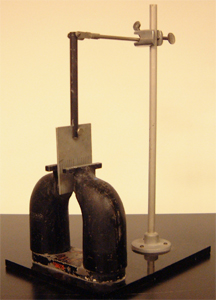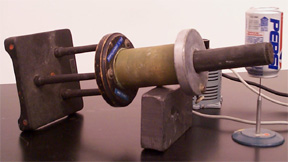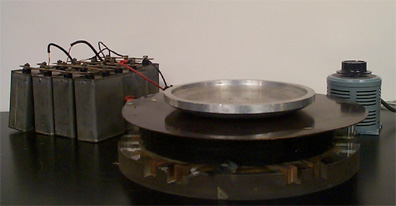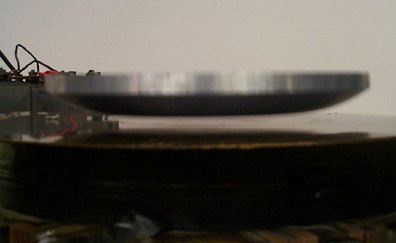
ELECTROMAGNETICS - EDDY CURRENTS

EM.5(1) - SWINGING ALUMINUM PLATE
A flat aluminum plate, about 5 cm x 8 cm, has slots cut out half-way through its long side. It has as a pendulum between the poles of a strong horse-shoe magnet. The plate can be set with the slotted side on its solid side on the magnetic field. When the continuous side hangs on the magnetic field, it does not swing -- if released from any height, the plate stops quickly in the region of the magnetic field. However, if the plate is inverted and ths slotted side is in the magnetic field region, the plate swings freely through the field.
It demonstrates the principle of an eddy current brake and conversely the effectiveness of laminated transformer cores for reduction of eddy currents.


EM.5(2) - EDDY CURRENT MOTOR
An empty soft drink can is placed upside-down on a stand, such that it is free to rotate. It is then set near to, but off of the side of, an electromagnet. The electromagnet is a large induction coil connected to an AC power supply. When the electromagnet is energized, the can spins. If the can is moved to the other side, it spins in the opposite direction. Induced eddy currents in the opposit sides of the can are in the same direction at any instant, thus the attraction between the currents causes a constant torque to be exerted on the can, resulting in its revolving motion.
Click here to download the video clip of this demo

EM.5(3) - EDDY CURRENT LEVITATOR
The levitator consists of an electromagnet, a bank of capacitors and an aluminum plate. It is operated by an alternating current power supply.
The electromagnet is built with four concentric coils and a laminated iron core. The four coils are wound in the same sense and connected to the capacitor bank such that the resulting circuit is a parallel resonant circuit. The capacitor is large enough to bring the circuit into resonance. Two coils are connected in parallel and then in series with the capacitor. This part is then connected in parallel with the other two coils. A vertorial analysis of this circuit shows that the voltage across the coils connected in series with the capacitor leads the applied voltage by approximately 180°.
The coils and the capacitors' banks are connected such that the magnetic fields induced have the space distribution that provides the needed stability for the aluminum plate.
The pole pieces of the laminated iron core reverse their polarity periodically with the alternating current in the coils. This changing magnetic field induces strong eddy currents in the aluminum pan sitting on top of the electromagnet. The eddy currents give rise to opposing magnetic fields, according to Lenz's Law, and the pan is continually subject to an upward force in the central region of the magnet.


EM.5(4) - LENZ'S LAW
An aluminum tube and a clear plastic tube are used to demonstrate Lenz's Law. A falling bullet-like magnet induces an electrical current in the aluminum tube, producing a counterforce on the magnet, causing it to fall slower than the other bullet in plastic tube when dropped simultaneously.
Dimensions:
